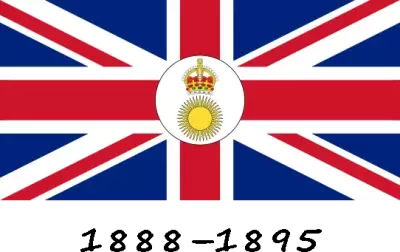Until 1895, the territory of modern Kenya was not a single state, but consisted of numerous ethnic groups - Kikuyu, Luo, Maasai, Swahili and others - who lived without centralized government or a single flag. During this period, the region was influenced by two main colonial powers: the Portuguese in the 16th and 17th centuries and the Omani Sultanate from the late 17th to the late 19th century. These foreign rulers left their mark on the Kenyan coast, but their flags did not reflect local traditions or culture.
In 1498, the Portuguese navigator Vasco da Gama became the first European to reach the East African coast, paving the way for colonization. From the beginning of the 16th century, Portugal established control over key coastal cities such as Mombasa, Malindi, and Lamu, seeking to monopolize the Indian Ocean trade in spices, ivory, and slaves. In 1593, the Portuguese built Fort Jesus in Mombasa, which became their main base in the region. They also established trading posts in Malindi and Kilifi, using these points to export goods to Europe and Asia. Portuguese rule was harsh: they imposed high taxes, forced the local population to labor, and clashed with Swahili communities and Arab traders. This resistance, along with competition with Omani Arabs, weakened their power. In 1698, Omani forces, supported by local Swahili, captured Mombasa, expelling the Portuguese from most of Kenya's coastal territories.
The flag of the Portuguese period was a white banner with a red cross of St. George, symbolizing the Catholic faith and Portuguese maritime power. In some cases, a flag with the kingdom's coat of arms, a shield with five blue shields and a red border, was used to denote the Avis dynasty and imperial ambitions. These flags had no connection to local culture and only emphasized foreign domination.
After the expulsion of the Portuguese, the Omani Sultanate established control over the East African coast, including the territory of modern Kenya. Zanzibar became the center of their power, and Mombasa, Lamu, and other coastal cities were governed by Omani governors. From the eighteenth century, the clove, slave, and ivory trade flourished, making Zanzibar a key port on the Indian Ocean. The Omani sultans supported trade with India, Arabia, and Europe, but the interior of Kenya remained under the control of local tribes such as the Maasai or the Kamba. In the nineteenth century, especially after 1856, when Zanzibar became an independent sultanate under Said bin Sultan, the trade network expanded even further. However, Omani rule was limited to the coast, and their power depended on cooperation with local Swahili leaders.
The flag of the Sultanate of Oman, and later the Sultanate of Zanzibar, was solid red. The red color symbolized the sultan's power, military strength, and trade power, but had no connection to the African population or culture of Kenya. This flag flew over Mombasa and other coastal cities, signifying Omani rule.
In the 1880s, European powers, particularly Britain and Germany, began to show interest in East Africa. In 1885, Germany established a protectorate over the mainland territories, and Britain gained influence over Zanzibar and part of the Kenyan coast under the Heligoland-Zanzibar Agreement of 1890. In 1888, the Imperial British East Africa Company (IBEAC) received a royal charter to govern the region. Its flag was the Union Jack with the company's emblem in the center, a golden sun and crown on a white disk, symbolizing British power and trade ambitions. This flag was used in administrative centers such as Mombasa, but did not contain local symbols.

In 1895, Britain proclaimed the East African Protectorate, covering modern-day Kenya, after removing the IBEAC, which had laid the Mombasa-Nairobi railroad, completed in 1901, and developed coffee and cotton plantations. Due to financial difficulties and resistance from local tribes such as the Nandi, the British government took direct control. The flag of the protectorate was the Blue Ensign with the Union Jack in the upper left corner and the emblem on the right. In 1895-1921, the emblem consisted of a red lion on a white disk, representing the power of the empire. In 1920, the protectorate became a Kenyan colony, and the flag changed: the red lion was placed directly on a blue background, without a white disk, with a 1:2 ratio. The Union Jack on all flags denoted the power of the British Empire, and the lion stood for courage and authority.

In the 1940s, the Kenya African Union (KAU), led by Jomo Kenyatta, used a flag with black, red, and green colors, with a shield, spear, and arrow in the center. Black symbolized the people, red the blood of the struggle, and green the earth. This flag, although unofficial, became the prototype for the national flag. Between 1952 and 1960, the Mau Mau uprising, led by the Kikuyu, claimed at least 11,000 African lives and thousands of European lives, accelerating the movement toward independence. In 1960-1963, constitutional conferences in London, with the participation of the KANU and KADU parties, prepared Kenya for self-government, which came on June 1, 1963.
On December 12, 1963, Kenya gained independence, and the new flag became a symbol of freedom. In 1960, KANU used a flag with black, red, and green colors, with a rooster and an axe, inspired by the 1920 pan-African flag. KADU proposed a tricolor with white stripes for peace. In 1961-1963, the design debate ended with a compromise presented on July 26, 1963: three horizontal stripes (black, red, green) separated by white stripes, with a Maasai shield and two spears in the center. The black color symbolizes the people of Kenya, the red color symbolizes the blood shed for independence, the green color symbolizes fertile land, and the white color symbolizes peace and harmony. The Maasai shield and spears represent the defense of freedom and cultural heritage. The proportions of the flag are 2:3, and it has remained unchanged since 1963, flying over Nairobi, Mombasa and Mount Kenya.







